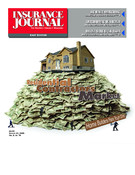Fire safety could become a hot topic in communities across the country as officials debate whether to adopt newly proposed rules requiring fire sprinklers in all new construction of one- and two-family dwellings.
The revised national building and fire safety code provisions, which were developed by the National Fire Protection Association, provide safety advocates with a new reason to press state and local authorities to adopt the sprinkler rules.
“We’ve seen some significant improvements in home safety but things have sort of plateaud in recent years,” Gary Keith, NFPA vice-president of regional operations, said, suggesting the sprinkler rules should provide a vehicle for renewed debate across the country.
Hundreds of local communities, including San Clemente, Calif. as early as 1978, Scottsdale, Ariz. in 1986 and, most recently, Oak Brook, Ill., have local ordinances requiring sprinklers in new residences. NFPA hopes its updated standards can serve as a model for others to follow.
“The code provision for sprinklers in new one- and two-family dwellings is a milestone in fire protection,” said James M. Shannon, president of NFPA, which is headquartered in Quincy, Mass. “It is a significant step in reducing the rate of fire death and injury in the place where people are at most risk for fire–their own homes.”
Far from sure thing
Even with the NFPA rules, however, widespread adoption is far from a sure thing for several reasons.
First, the NFPA has major competition in the field of safety standards. Its competitor, the International Code Council, whose building codes are actually the most widely-adopted, has yet to officially weigh in on the subject. According to ICC’s spokesperson, Jennifer Gibson, ICC is still in the process of developing a “low cost standard” for residential sprinklers, such as a multi-purpose or combination fire and plumbing system, which can be less expensive than a dedicated fire sprinkler system. Some jurisdictions may decide to wait to see what ICC says.
While safety advocates hail the home sprinkler provision as a major step forward, some home builders and real estate interests oppose mandating sprinklers because it is “not cost-effective,” according to Larry Brown, construction and standard code specialist for the National Home Builders Association.
“NFPA doesn’t care about whether it’s cost-effective. They just want to go around putting sprinklers in everywhere,” he claimed.
NAHB says a sprinkler system can cost from $5,000 to $15,000 depending on the size and location of the house. Brown said that this money spent would be better spent on smoke alarms, especially in inner city and rural areas.
The cost of a sprinkler mandate is also an issue because it would force many buyers out of the real estate market, the home builders argue. “Our economists tell us that for every $1,000 added to the cost of a home, you price 240,000 out of buying a new house,” said Donna Reichle, NAHB spokesperson.
NAHB would support a mandate for a multi-purpose system if it were low cost, Brown said. Meanwhile, NAHB has petitioned to block the change in the NFPA sprinkler code.
Cost issue
NFPA dismisses the cost complaint, claiming that including home sprinklers in home construction adds from one to two percent to the cost, and this cost goes down as more homes are built with the safety feature.
NFPA is aware that acceptance of new standards does not happen overnight. Keith likens the upcoming debate to what transpired over airbags in cars. The bags were initially opposed by manufacturers but are now an accepted feature. “We know there has to be a certain amount of time for people to become comfortable with the idea,” he noted.
Keith recently visited an over-55 development in Windsor Locks, Conn. that built sprinklers into all of its housing units. He said the inclusion of sprinklers aided the developer because it meant fewer fire hydrants and access routes, thus freeing space to build more units. The sprinklers have become a selling advantage, Keith added.
The NFPA code revisions also include commercial provisions. Fire sprinklers would be required in all new and existing nursing homes and in all most nightclubs. The sprinkler provision for nightclubs came in the aftermath of the February2003 Station Nightclub fire in West Warwick, R.I., where 100 people died. Nursing home fires in Hartford and Nashville led to a push for better fire protection in nursing facilities.
“These tragedies have taught us that we must do more to keep our elderly and disabled safe from fire,” NFPA’s Shannon said.
Was this article valuable?
Here are more articles you may enjoy.


 US P/C Posts $35B YTD Underwriting Gain; By-Line Premium Growth Revealed
US P/C Posts $35B YTD Underwriting Gain; By-Line Premium Growth Revealed  Senators Launch Probe Into Demotech’s Ratings in Florida
Senators Launch Probe Into Demotech’s Ratings in Florida  Stepbrother Suspect in Cruise Ship Death Says He Doesn’t Remember Anything
Stepbrother Suspect in Cruise Ship Death Says He Doesn’t Remember Anything  Freight Broker Says $400K in Lobster Meat Stolen in Fictitious Pickup
Freight Broker Says $400K in Lobster Meat Stolen in Fictitious Pickup 


